Connect With Us
Blog
October 2024
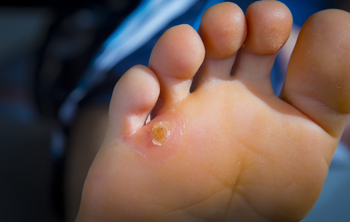
Corns on the pinky toe are thickened areas of skin that form in response to pressure or friction. They often develop on the outer side of the pinky toe due to constant rubbing against tight or ill-fitting shoes. Corns can be hard or soft, with hard corns typically forming on the bony areas, and soft corns appearing between toes where moisture is present. Symptoms include a hardened, raised bump that can be painful when pressed, redness, and irritation. The pain can intensify with continued friction, making walking uncomfortable. To prevent corns, wear properly fitting shoes with a wide toe box and cushioned insoles. Regularly moisturizing and using a pumice stone on your feet can also help keep the skin soft. If you have a painful or infected corn on any toe, it is suggested that you visit a podiatrist who can provide care, which might include shaving or safely removing the corn.
If you have any concerns regarding your feet and ankles, contact Cary Golub, DPM of New York. Our doctor will treat your foot and ankle needs.
Corns: What Are They? and How Do You Get Rid of Them?
Corns can be described as areas of the skin that have thickened to the point of becoming painful or irritating. They are often layers and layers of the skin that have become dry and rough, and are normally smaller than calluses.
Ways to Prevent Corns
There are many ways to get rid of painful corns such as wearing:
- Well-fitting socks
- Comfortable shoes that are not tight around your foot
- Shoes that offer support
Treating Corns
Treatment of corns involves removing the dead skin that has built up in the specific area of the foot. Consult with Our doctor to determine the best treatment option for your case of corns.
If you have any questions please feel free to contact our offices located in Williston Park, and Long Beach, NY . We offer the newest diagnostic and treatment technologies for all your foot and ankle needs.
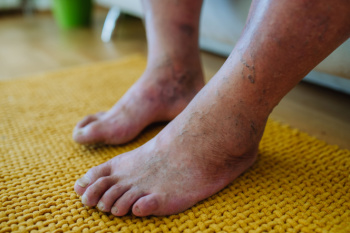
Foot problems in diabetic patients are a leading cause of lower extremity amputations, often resulting from poor circulation and nerve damage, or neuropathy. Diabetes can reduce sensation in the feet, making it difficult to notice injuries like cuts, blisters, or ulcers. These minor injuries can easily become infected, and due to poor healing capacity, infections may worsen and lead to more severe symptoms, if not treated promptly. Regular foot screenings are essential for diabetic patients and education plays a critical role in diabetic foot care. If you have diabetes, it is strongly suggested that you have your feet checked by a podiatrist regularly for early detection of potential complications.
Diabetic foot care is important in preventing foot ailments such as ulcers. If you are suffering from diabetes or have any other concerns about your feet, contact Cary Golub, DPM from New York. Our doctor can provide the care you need to keep you pain-free and on your feet.
Diabetic Foot Care
Diabetes affects millions of people every year. The condition can damage blood vessels in many parts of the body, especially the feet. Because of this, taking care of your feet is essential if you have diabetes, and having a podiatrist help monitor your foot health is highly recommended.
The Importance of Caring for Your Feet
- Routinely inspect your feet for bruises or sores.
- Wear socks that fit your feet comfortably.
- Wear comfortable shoes that provide adequate support.
Patients with diabetes should have their doctor monitor their blood levels, as blood sugar levels play such a huge role in diabetic care. Monitoring these levels on a regular basis is highly advised.
It is always best to inform your healthcare professional of any concerns you may have regarding your feet, especially for diabetic patients. Early treatment and routine foot examinations are keys to maintaining proper health, especially because severe complications can arise if proper treatment is not applied.
If you have any questions please feel free to contact our offices located in Williston Park, and Long Beach, NY . We offer the newest diagnostic and treatment technologies for all your foot and ankle needs.
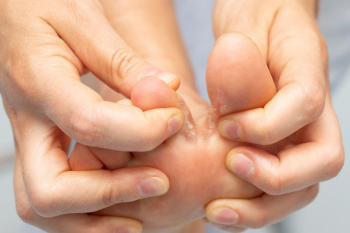
Athlete's foot is a fungal infection that typically affects the skin between the toes, though it can spread to other areas of the foot. It often appears as red, itchy, and scaly patches, sometimes with blisters or cracks in the skin. The infection causes a burning or stinging sensation and can lead to peeling skin or thickened areas, particularly on the soles or edges of the foot. Athlete's foot spreads easily through direct contact with contaminated surfaces, such as locker room floors, showers, or towels, making it extremely contagious. If left untreated, the infection can worsen, leading to more widespread skin damage, secondary bacterial infections, or even spreading to the nails, causing onychomycosis. Treatment and prevention include keeping feet clean and dry and wearing breathable footwear. In persistent cases, prescription-strength antifungal medications may be needed to fully resolve the infection. If you have athlete’s foot, it is suggested that you visit a podiatrist for care.
Athlete’s Foot
Athlete’s foot is often an uncomfortable condition to experience. Thankfully, podiatrists specialize in treating athlete’s foot and offer the best treatment options. If you have any questions about athlete’s foot, consult with Cary Golub, DPM from New York. Our doctor will assess your condition and provide you with quality treatment.
What Is Athlete’s Foot?
Tinea pedis, more commonly known as athlete’s foot, is a non-serious and common fungal infection of the foot. Athlete’s foot is contagious and can be contracted by touching someone who has it or infected surfaces. The most common places contaminated by it are public showers, locker rooms, and swimming pools. Once contracted, it grows on feet that are left inside moist, dark, and warm shoes and socks.
Prevention
The most effective ways to prevent athlete’s foot include:
- Thoroughly washing and drying feet
- Avoid going barefoot in locker rooms and public showers
- Using shower shoes in public showers
- Wearing socks that allow the feet to breathe
- Changing socks and shoes frequently if you sweat a lot
Symptoms
Athlete’s foot initially occurs as a rash between the toes. However, if left undiagnosed, it can spread to the sides and bottom of the feet, toenails, and if touched by hand, the hands themselves. Symptoms include:
- Redness
- Burning
- Itching
- Scaly and peeling skin
Diagnosis and Treatment
Diagnosis is quick and easy. Skin samples will be taken and either viewed under a microscope or sent to a lab for testing. Sometimes, a podiatrist can diagnose it based on simply looking at it. Once confirmed, treatment options include oral and topical antifungal medications.
If you have any questions, please feel free to contact our offices located in Williston Park, and Long Beach, NY . We offer the newest diagnostic and treatment technologies for all your foot care needs.
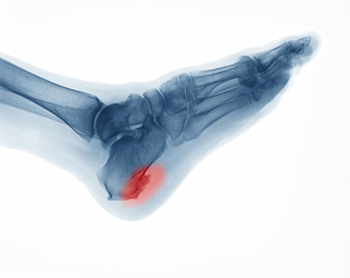
Bone spurs, or osteophytes, are bony growths that can develop on the heel due to excessive stress, injury, or conditions like plantar fasciitis. These spurs typically form where tendons and ligaments attach to the bone, causing localized pain and discomfort. Symptoms of heel bone spurs include sharp or aching pain, especially with the first steps in the morning or after prolonged periods of rest. Swelling and inflammation surrounding the heel may also be present. Relief often involves a combination of approaches to alleviate pain and reduce inflammation. This can include wearing supportive footwear, using custom orthotics, and resting the affected area. Stretching exercises may also be beneficial. In more severe cases, corticosteroid injections or surgery might be necessary. To address heel pain and explore effective treatments, it is suggested you schedule an appointment with a podiatrist who can provide tailored care for your condition.
Heel spurs can be incredibly painful and sometimes may make you unable to participate in physical activities. To get medical care for your heel spurs, contact Cary Golub, DPM from New York. Our doctor will do everything possible to treat your condition.
Heels Spurs
Heel spurs are formed by calcium deposits on the back of the foot where the heel is. This can also be caused by small fragments of bone breaking off one section of the foot, attaching onto the back of the foot. Heel spurs can also be bone growth on the back of the foot and may grow in the direction of the arch of the foot.
Older individuals usually suffer from heel spurs and pain sometimes intensifies with age. One of the main condition's spurs are related to is plantar fasciitis.
Pain
The pain associated with spurs is often because of weight placed on the feet. When someone is walking, their entire weight is concentrated on the feet. Bone spurs then have the tendency to affect other bones and tissues around the foot. As the pain continues, the feet will become tender and sensitive over time.
Treatments
There are many ways to treat heel spurs. If one is suffering from heel spurs in conjunction with pain, there are several methods for healing. Medication, surgery, and herbal care are some options.
If you have any questions feel free to contact our offices located in Williston Park, and Long Beach, NY . We offer the latest in diagnostic and treatment technology to meet your needs.
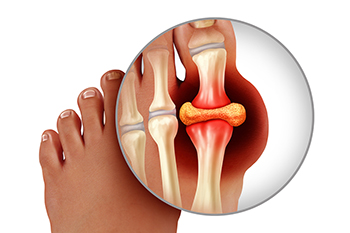
Gout is a form of arthritis that commonly affects the feet, particularly the big toe, and can often be controlled with medications and lifestyle changes. However, when gout progresses and causes significant joint damage or chronic pain, surgery may be necessary. Surgery for gout is typically considered when uric acid deposits, called tophi, form around the joints and lead to severe pain, deformities, or infections. The three main types of surgery are tophi removal, joint fusion, and joint replacement. Tophi removal involves cutting out the painful deposits while preserving healthy tissue. Joint fusion stabilizes the bones to relieve pain but may reduce mobility. Joint replacement, used in more advanced cases, involves putting in an artificial joint to improve function and reduce discomfort. A podiatrist can help determine the most appropriate gout treatment based on the severity of the condition. If you have chronic pain from gout, it is suggested that you schedule an appointment with a podiatrist wh can determine if surgery is needed.
Gout is a painful condition that can be treated. If you are seeking treatment, contact Cary Golub, DPM from New York. Our doctor will treat your foot and ankle needs.
What Is Gout?
Gout is a form of arthritis that is characterized by sudden, severe attacks of pain, redness, and tenderness in the joints. The condition usually affects the joint at the base of the big toe. A gout attack can occur at any random time, such as the middle of the night while you are asleep.
Symptoms
- Intense Joint Pain - Usually around the large joint of your big toe, and it most severe within the first four to twelve hours
- Lingering Discomfort - Joint discomfort may last from a few days to a few weeks
- Inflammation and Redness -Affected joints may become swollen, tender, warm and red
- Limited Range of Motion - May experience a decrease in joint mobility
Risk Factors
- Genetics - If family members have gout, you’re more likely to have it
- Medications - Diuretic medications can raise uric acid levels
- Gender/Age - Gout is more common in men until the age of 60. It is believed that estrogen protects women until that point
- Diet - Eating red meat and shellfish increases your risk
- Alcohol - Having more than two alcoholic drinks per day increases your risk
- Obesity - Obese people are at a higher risk for gout
Prior to visiting your podiatrist to receive treatment for gout, there are a few things you should do beforehand. If you have gout you should write down your symptoms--including when they started and how often you experience them, important medical information you may have, and any questions you may have. Writing down these three things will help your podiatrist in assessing your specific situation so that he or she may provide the best route of treatment for you.
If you have any questions, please feel free to contact our offices located in Williston Park, and Long Beach, NY . We offer the newest diagnostic and treatment technologies for all your foot care needs.
Blog Archives
- 2025
- 2024
- 2023
- 2022
- 2021
- 2020

